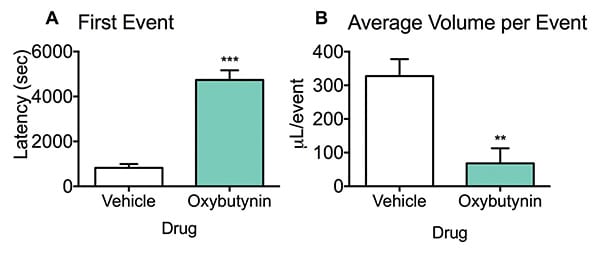Micturition, Urinary Incontinence, Overactive Bladder
Discover how Melior’s unique phenotypic screening platforms can uncover the untapped value of your candidate therapeutic
Micturition is a parasympathetic function of the nervous system and is achieved by complex neurological mechanisms involving the somatic, autonomic and central components of the urinary system.
Micturition disorders are classified as disturbances in bladder storage or emptying. The failure to store urine leads to urgent and stress-related incontinence.
The study summarized below illustrates the validation of a micturition model in which latency to urinate and urination volume were produced by an oxybutynin challenge and measured using an automated collection chamber. The equipment that Melior has developed for conducting this procedure in mice can precisely determine the latency to the first micturition event, total number event in a given period, and total volume over a given period. It is particularly well-suited for evaluating therapeutic candidates for overactive bladder and urinary incontinence in mice.
Ready to get started or looking for a custom model?
Contact us today for more information about our bespoke research models and to discuss how we can help you answer your unique research questions.

After a 24-hour fast, mice were injected with vehicle and 1.0 mL water subcutaneously. Oxybutynin (100mg/kg) was orally administered 5 minutes after water administration and mice were placed in the automated chambers for 90 minutes. Oxybutynin caused a significant increase in latency to urinate (A) as well as a reduction in urination volume (B). Data are mean ± SEM; **p<0.01, ***p<0.001 compared to vehicle (N=6).
The micturition assay is a one day procedure and can be used in an acute mode (i.e. one day study to look at compound effect after a single administration). Since the procedure is non-invasive it also lends itself well to incorporate at several time points over the course of a chronic model or treatment regimen. This test can be conducted in mice or rats although the procedure somewhat better suited for mice.
